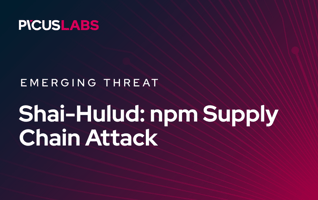BAS vs Automated Pentesting: Safe Testing in Production
Many organizations hesitate to conduct security testing in production environments out of fear of disruption or downtime. This is a valid concern, especially for organizations operating 24/7 services or managing sensitive infrastructure. However, avoiding production testing altogether leaves security teams with an incomplete view of their true readiness.
That's why Adversarial Exposure Validation (AEV) technologies like Breach and Attack Simulation (BAS) and Automated Penetration Testing are designed to operate safely in live environments. These solutions help organizations validate their defenses under real-world conditions without compromising performance or availability.
In this fourth installment of our "BAS vs Automated Pentesting" series, we explore why testing in production environments is essential, how BAS and Automated Pentesting enable it safely, and how the two approaches compare in balancing thoroughness with operational safety.
Looking for a BAS solution? Check out our Free Trial and See Picus in Action
Why Testing in Production Matters
Security controls often behave differently in production environments than they do in test or lab settings. This is because production systems are complex, dynamic, and constantly evolving. Interdependencies, traffic volumes, and system behaviors that exist in real environments can't always be replicated in isolated environments. A configuration that works well in staging may fail under real-world load. A detection rule that fires in testing might miss a threat in production due to logging gaps or ingestion issues.
Testing only in non-production environments creates a false sense of security. It validates controls under ideal conditions but fails to reflect the real performance of your defenses under stress. Testing in production is essential because it uncovers real blind spots, misconfigurations, and integration failures that would otherwise go unnoticed. This is especially critical in fast-moving IT environments like cloud-native apps, CI/CD pipelines, and remote workforces where changes happen continuously. The longer you delay testing in production, the further your security posture drifts from reality. That's why safe, controlled validation in production is no longer optional.
How BAS and Automated Pentesting Enable Safe Testing in Production
To address concerns about instability that might be caused by testing in production, BAS and Automated Pentesting solutions are engineered with safety as a core design principle. Their shared goal is to simulate adversary behavior in a way that validates defenses without risking system integrity, data loss, or downtime.
Breach and Attack Simulation (BAS) solutions are known for their non-intrusive, low-impact simulations. These solutions replicate attack techniques such as initial access, lateral movement, credential dumping, or data exfiltration without executing actual payloads or causing system changes. Simulations are typically powered by lightweight agents that interact with security controls like EDRs, SIEMs, and firewalls in a controlled, observable manner.
Rather than attempting to exploit systems to inflict harm, BAS solutions check whether a control logs, blocks, or alerts on simulated behavior. They avoid disruptions and can be run safely across production infrastructure. The focus is on validating detection and prevention capabilities.
Automated Penetration Testing solutions also prioritize safety but take a more interactive approach. Automated Pentesting solutions simulate realistic multi-step attack paths, including chaining vulnerabilities, privilege escalations, and lateral movement. However, they are designed to stop short of any action that would cause harm. For example, Automated Pentesting solutions may simulate domain takeover or ransomware activity, but they won't deliver destructive payloads or modify sensitive data.
Modern Automated Pentesting solutions include real-time monitoring, execution limits, rollback options, and test scoping to ensure safety. They often allow tests to be scheduled during off-peak hours or maintenance windows and can be paused immediately if any instability is detected. These controls give teams the confidence to run simulations in live environments without risking performance or uptime.
Comparing BAS and Automated Pentesting in Production Testing
Although both BAS and Automated Pentesting are designed to be safe in production, they differ in their depth, scope, and operational touchpoints. Understanding these differences is key to choosing the right approach or combination of approaches for your environment.
BAS is inherently less intrusive. It's designed to simulate individual attack techniques to determine whether security controls detect and respond as expected. It doesn't harmfully exploit systems or make meaningful changes to their state. This makes it ideal for organizations seeking high-frequency, broad-scope validation with minimal operational overhead.
For example, BAS might simulate a privilege escalation or credential harvesting attempt and verify whether the SIEM logs the event or the EDR blocks it. The activity is contained, safe, and completely observable. No files are encrypted. No privileges are altered. No systems are accessed beyond simulation boundaries.
This makes BAS particularly valuable for organizations with strict uptime requirements or highly regulated environments. It enables teams to continuously validate detection and prevention across endpoints, networks, cloud environments, and applications without interfering with live operations.
Automated Pentesting offers deeper, scenario-driven validation. It mimics real attacker behavior by chaining multiple weaknesses to simulate full attack paths. These include authentication bypasses, misconfigurations, and privilege escalations all tested in ways that reflect how breaches actually unfold.
While still safe, Automated Pentesting interacts more directly with the environment. It may attempt to authenticate with weak credentials, probe lateral movement opportunities, or demonstrate how an attacker could reach sensitive assets. This provides richer context and impact visibility, helping teams understand the true consequences of unaddressed exposures.
The strength of Automated Pentesting lies in its depth and realism. It answers architectural questions such as: Can an attacker pivot from a misconfigured web server to a domain controller? What controls block lateral movement? What's the blast radius if a control fails?
Automated Pentesting solutions offer granular controls to ensure testing does not cross predefined safety thresholds. Execution limits, monitoring dashboards, and customizable scoping allow teams to define how far a simulation can go, making it a powerful alternative to manual red teaming or audit-based assessments.
What's Next
In this fourth entry in our "BAS vs Automated Pentesting" series, we explored how both technologies enable safe, continuous testing in production environments, empowering security teams to validate defenses without risking disruption.
Next, we'll shift focus to red team operations and examine how BAS and Automated Pentesting support scalable, automated offensive testing. We'll break down how these solutions help emulate attacker behavior, simulate breach scenarios, and operationalize red teaming efforts across the organization without the time, cost, or complexity of traditional manual engagements.
Stay with us as we continue to explore the practical applications of BAS and Automated Pentesting across every layer of modern exposure validation.








